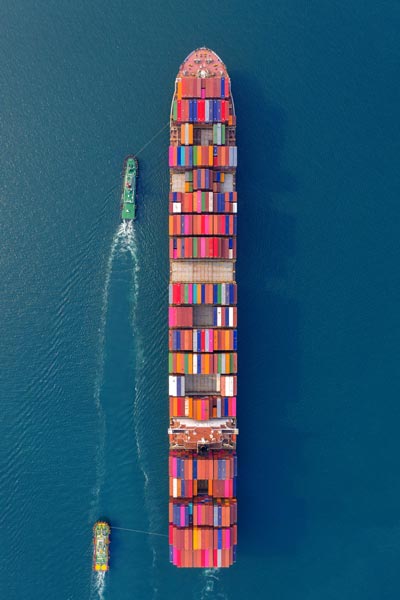ARTICLES
WILL THERE BE A NEW GEOPOLITICAL AGENDA FOR THE WORLD ECONOMY AFTER UKRAINE?
WE ARE WITNESSING CHANGES IN THE POLITICAL POWER, THE ROLE
OF COMPANIES, AND THE MECHANISMS OF DECISION-MAKING.
Introduction
Total Argentine exports are recovering after the big drop in 2020. In the first six months of 2021, according to the National Institute of Statistics and Census of Argentina (INDEC), exports reached 35,339 million dollars and imports 28,599 million dollars.
Trade (exports plus imports) increased 36.6% and reached a value of 63,938 million dollars. The trade balance registered a surplus of 6,740 million dollars. In all cases, the variations corresponded to the same period of the previous year.
Exports increased 28.3% (7,786 million dollars) as a result of increases in quantities (4.7%) and prices (22.4%). Imports grew 48.6% (9,358 million dollars) due to 36.95% increase in quantities and 8.6% rise in prices.
And it should be noted that there are non-traditional markets growing in recent times at a rate of two percentage digits every year.
The Middle East
is a market of opportunities
Trade with this bloc had a surplus of 1,992 million dollars from January to June 2021. It was the third significantly positive balance after those registered with ASEAN, the Maghreb and Egypt.
Exports to this region totaled 2,551 million dollars and increased 66.1% compared to the same period in 2020 (1,015 million dollars).
Imports totaled 559 million dollars and grew 175.4% (356 million dollars).
Trade with the Middle East represented 7.2% of exports and 2.0% of total imports.
Already in 2020, the annual total of exports to the Middle East had been relevant.
FOREIGN TRADE 2021 – 2022 REPORT
Marcelo elizondo Special Report

2021 Coming to an end with satisfactory results in foreign trade (due to exogenous and hardly repeatable reasons) In 2022 exports would not grow and the balance of trade would reduce

Marcelo Elizondo
President of the International Chamber of Commerce in Argentina.
Director of Master’s Degree in Strategic and Technological Development at ITBA.
President of LIDE International.
Member of the Board of Directors of the Argentine Chamber of Commerce and Services (CACyS in Spanish).
General Director of Consulting Company “DNI”.
Consultant Member of the Argentine Council for the International Relations (CARI in Spanish).
Member of the Advisory Council of the Argentine-Lebanese Chamber of Commerce.
Annual Argentine exports by selected country in millions of dollars
year 2020
Barhain
USD 2.649.875
cereals USD 165.493
CHEMICALS USD 159.345
—-
Egypt
USD 1.168.097.652
cereals USD 637.844.458
oil seeds USD 193.885.278
fats and oils USD 102.706.229
—-
Iraq
USD 295.978.711
soy pellets USD 84.459.488
cereals USD 39.751.312
—-
Israel
USD 285.135.417
meats USD 164.522.012
soy pellets USD 23.962.086
—-
Jordan
USD 202.640.463
soy pellets USD 60.319.015
fish USD 2.628.405
—-
Kuwait
USD 44.996.208
cereals USD 41.043.048
—-
Lebanon
USD 98.407.762
cereals USD 37.402.246
soy pellets USD 24.364.538
—-
Libya
USD 37.697.569
cereals USD 4.633.080
—-
Morocco
USD 486.740.478
cereals USD 251.794.232
fats and oils USD 85.315.073
—-
Mauritania
USD 611.763
—-
Oman
USD 58.780.679
cereals USD 35.839.290
soy pellets USD 10.874.473
—-
Palestine
USD 627.445
—-
Qatar
USD 28.742.862
chemicals USD 671.485
alcoholics drinks USD 558.460
—-
Saudi arabia
USD 957.650.000
cereals USD 471.674.156
soy pellets USD 161.745.636
—-
Sudan
USD 620.749
—-
Syria
USD 68.951.479
yerba mate and infusions USD 61.971.002
—-
Tunisia
USD 85.338.900
cereals USD 35.363.926
—-
united arab Emirates
USD 539.083.066
cereals USD 69.431.179
soy pellets USD 10.390.532
oilseeds USD 7.700.272
—-
Yemen
USD 215.266.190
cereals USD 112.778.781
soy pellets USD 61.930.481
—-
TOTAL USD 4.578.017.268
An approach on
non-traditional markets
Therefore, it is not only important to work in order to sell more, but also to sell better. And this, among other things, implies reaching non-traditional markets. For that reason, it is critical to act strategically (access to external markets requires to have a clear target goal to choose the means, and to measure results, since, actually, commercial strategies are sold instead of products and the base of the strategy must be a qualified product, appropriate to the chosen market segment).
Concomitantly, it is important to work, as complete as possible, in the knowledge of the market to be addressed. Business intelligence is thus essential in the strategy.
Nobody wins a market that they do not know, for which, according to Jeannet and Hennessey, it is necessary to think about the differences among the markets, industry conditions, commercial institutions, legal restrictions, customs and practice and so on.
Thus, companies can rely on the institutions that form the “architecture”, as it is called by Professor John Kay, from the London Business School: the network of stable, continuous, reliable, spontaneous -not imposed- and useful relationships that a company must create to be successful. The more capacity you have in creating those networks (in which value is added), the more successful you will be.
Apart from that, it is pertinent to have good partners in the project, from suppliers of raw material, inputs and services for production, to service providers that allow it to reach the client (to mention some examples: logistics and transport, dispatch , financing, distribution in the target market, after-sales service, and so on).
And, insofar as it is possible to advance in the development of the market, it is useful to work with commercial brands, where various products (from textiles with design to food and beverages, through software or machines and devices) can grow considerably, and examples can already be seen.
In stores of different dimensions – clothing, cafeteria, ice cream parlor, bakery products, packed meat, edible oils, wines or several machines and equipment, to give a few different examples – there is a way to go based on formal identification with commercial value, knowledge, image and positioning that shall be compensated by the external consumer due to a value created in this way.
Non-traditional markets can be a great alternative for large or small companies, and also provide profitable opportunities. The appropriate strategy for each one, thus, the first step on the critical path.
The Middle East is an opportunity

In the Middle East there are markets that have a sharp rise in the first semester: Tunisia, Libya, and Egypt are an example. And others whose percentage evolution is not so outstanding, but in absolute numbers they are relevant: Egypt, United Arab Emirates, Saudi Arabia, Morocco, Yemen, and Tunisia.
There are two big approaches to do in this matter.
On the one hand, an agenda of needs that can be raised to improve access to these markets.
Achieving a greater quantity and better volume of exports in these markets requires the implementation of several resources that allow production to obtain the expected development.
For the sole purpose of considering the possible main measures in this regard, five of the most important ones are mentioned below:
- Tend to reduce the burden of export taxes (withholdings), especially for small and medium-sized enterprises (SMEs).
- Reduce the internal tax burden for exporters (especially in income tax and turnover taxes in the production chain) mainly for medium and small producers and particularly for those that generate a greater adding value in the production chain (which can be implemented through reimbursements or even refunds).
- Tend to the validity of an exchange rate (at which exports are settled) converging with the prices that arise from market operations (reduce the so-called exchange gap).
- Implement a new offer of credit for production in general and specifically for the development of innovation and productive technology.
- Encourage, through tax incentives, greater care of the soil and the implementation of good productive practices, as well as the certification of standards and good productive practices.
To increase exports
However, on the other hand, and while the above occurs, the Argentine Lebanese Chamber intends to offer services to take advantage of opportunities:
Resources:
A) Relevant commercial information (market intelligence, especially in terms of the appropriate market for the companies receiving the service provided, qualitative and quantitative conditions of access to that market, references on the product to be commercialized in the market and better ways of positioning therein, analysis of economic, regulatory, commercial conditions, and so on).
B) Technical assistance (in order to collaborate with the company in the creation of competitive attributes: microeconomic competitiveness).
C) Assistance for the access to transnational chains of production, commercialization and operation: international value chains.
D) Landing in markets: Adequate on-site positioning services: commercial promotion (business trips, commercial rounds, participation in bilateral meetings or in general or multilateral promotional events of commercial linkage, product promotion actions, and follow-up tasks in the markets after business trips).

CONTACT
Av. Pres. Roque Sáenz Peña 651, 7º floor,
Autonomous City of Buenos Aires (C1035AAB)
+ 54 11 4326-7889
secretaria@camaralibanesa.com.ar
DISEÑO ESTUDIO 3C


